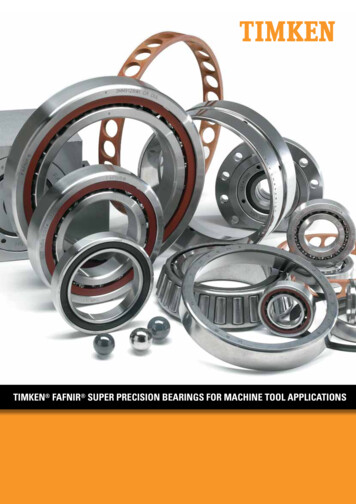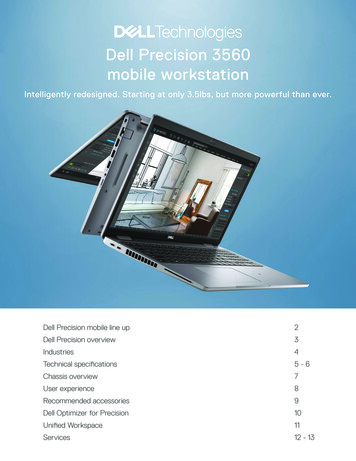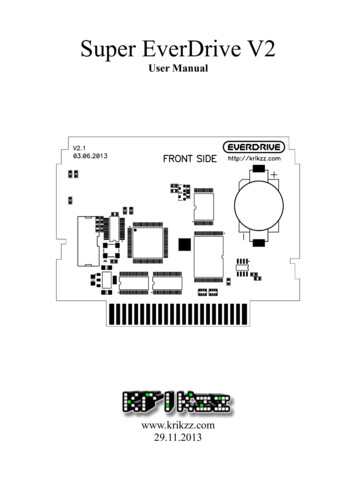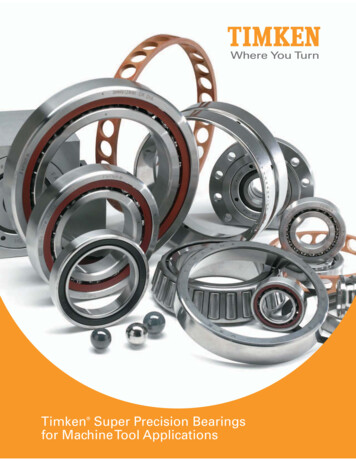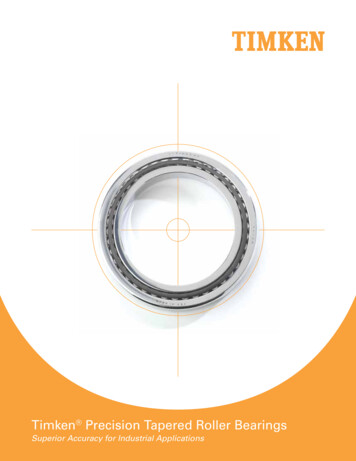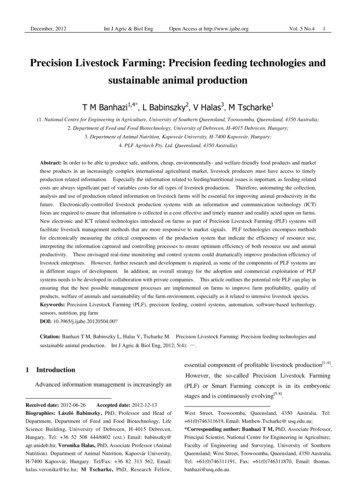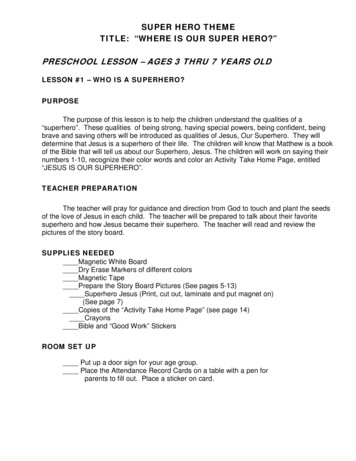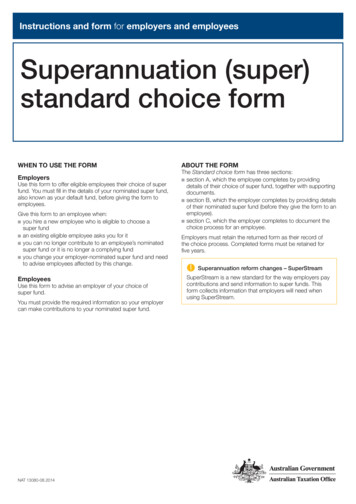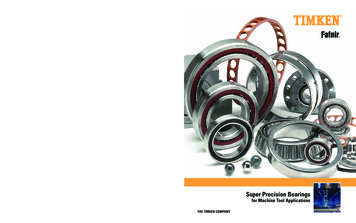
Transcription
The Timken Company is your resource for comprehensive machine tool application solutions. To learn more abouthow Timken can improve your operations, visit www.timken.com or call one of our global locations – 330.438.3000 (Canton,Super Precision Bearingsfor Machine Tool ApplicationsOhio, USA), 86.106.410.6490(Beijing, China), 33.389.21.4444 (Colmar, France) or91.80.5529234 (Bangalore, India).Super Precision BearingsTimken , Fafnir and Torrington are registered trademarks ofThe Timken Company.www.timken.com 2005 The Timken CompanyPrinted in USA10M 02-05-10 Order No. 5918for Machine Tool ApplicationsWorldwide leader in bearings andTHE TIMKEN COMPANY
Super Precision Bearings Machine Tool Spindle Ball Screw SupportTimken Super Precision Bearings / 1timsect1.pm6513/16/05, 10:09 AM
timsect1.pm6523/16/05, 10:09 AM
.About The Timken CompanyUsing This CatalogTerms and Conditions of SaleWarranty and LiabilitiesThe Bearing Selection ProcessBearing Operating ConditionsGeneral Bearing Selection Guidelines12 . . .13 . . .15 . . .202223242426.Tapered Roller Bearing NomenclatureBearing IdentificationTag MarkingsBearing Replacement and InspectionPrecision Bearing TypesTSF Style Sizes2830343638 .40 .41 .44 .58 .72 .86 .100114122.Ball Bearing NomenclatureSelective AssemblyApplications Examples2(3)MM9300WI Series2(3)MMV9300HX Series2(3)MM9100WI Series2(3)MMV9100HX Series2(3)MMV99100WN SeriesMM9100K Series2(3)MM200WI Series136140148152162182183184187190195202.206 . .213 . .215 . .IntroductionGrease Shelf Life and Storage PolicySpindle System CharacteristicsBearing SelectionTolerancesFitting Practices – Tapered Roller BearingsShaft and Housing Tolerances; GeometryRequirementsMountingMounting Duplex Ball BearingsRunout247248250252More Friction Management SolutionsTimken SolutionsFafnir SolutionsAvailable Services18 . . .Timken Super Precision BearingsRoller Bearings vs. Ball BearingsTimken Precision Tapered RollerBearingsTimken Fafnir Super Precision BallBearingsBearingSelection4 .4 .5 .5 .8 .1011.TS Style Sizes – InchTS Style Sizes – MetricHydraRib Style SizesTXR Style Sizes – Metric, Inch.170 . .178 . .MM200K Series2(3)MM300WI SeriesMM300K SeriesBall Screw Support Bearings – Inch, MetricBall Screw Support BearingCartridge UnitsBall Screw Support Bearing PillowBlock UnitsSealed Ball Screw Support BearingsEx-Cell-O Replacement Spindle Bearings216218218220223226230238242243Setting GuidelinesPreloadingLubrication – Tapered Roller BearingsLubrication – Ball BearingsRun In ProceduresHeat GenerationLife Calculations – Tapered Roller BearingsLife Calculations – Radial Ball BearingsPermissible Operating SpeedEffect of Lubrication on Speed Capability2.FrictionManagementSolutions4.5256 . .268 . .269 . .6270 . .271 . .272 . .Ball Bearing Frequency CoefficientsTapered Roller Bearing Tags:Runout DeviationTapered Roller Bearing GeometryConstantsSpeed Guidelines – Tapered Roller BearingsBall Bearing Radial Internal ClearancesBearing Locknuts and Torque Values273 . .274 . .Timken Lubrication SpecificationsOperating Temperatures for ComponentMaterials277 . .IndexAppendix/Index3166 . .Super PrecisionBall Bearings.EngineeringData.Precision TaperedRoller Bearings1Timken Super Precision Bearings / 3timsect1.pm6533/17/05, 2:59 PM
About The Timken CompanyUsing This CatalogThe Timken Company was founded in St. Louis in 1899by Henry Timken with his patented design for the taperedroller bearing. Five generations of Timken family membershave led the company as it developed an ever-increasingnumber of tapered roller bearing designs and applications.In 1917, the company entered the steel business toensure an uninterrupted supply of bearing-quality steel.Through international acquisitions in the 1990’s, thecompany expanded its product offering to include otherbearing types, including ball bearings, and cylindricaland spherical roller bearings.Timken’s acquisition of The Torrington Companyin 2003 combined two organizations sharing a verysimilar heritage, brand promise and market approach.Both companies have demonstrated traditions of quality,technology and innovation. Further, both have earnedthe respect of their customers due to a collaborative,customer-centric approach to identifying and implementing solutions.Through the acquisition, Timken is providing abroader range of friction-management products andservices. Timken has expanded its position as a leadingglobal manufacturer of alloy steel and tapered and needleroller bearings for the aerospace, automotive, industrialand rail markets. Specifically, its industry credentialsnow include:We are committed to providing our customers withmaximum service and quality. The part number of theproduct supplied may differ from those listed in thesepages. This catalog contains dimensions, tolerances andload ratings, as well as an engineering section describingfitting practices for shafts and housings, internal clearances, materials, and other features of bearings. It canprovide valuable assistance in the initial consideration ofthe type and characteristics of the bearing which may bemost suitable for particular needs.This data is intended for reference purposes only andwill assist the customer in part number and externalbearing dimension identification.Every effort has been made to ensure the accuracy ofthe information contained but no liability can be accepted for errors, omissions or any other reason.ISO, DIN, and ABMA, as used in this catalog, refer tothe International Organization for Standardization,Deutsches Institut für Normung EV and the AmericanBearing Manufacturers Association, respectively. Largest tapered roller bearing manufacturerworldwide Third largest bearings manufacturer worldwideSales Engineering ServicesTurn to Timken and its highly trained sales engineers whoare available to work toward solving new or unusualproblems. Timken may have already solved a similarproblem to yours and can offer a speedy, cost-effectivesolution.To get the best performance out of the application,especially when operating conditions are critical, contactyour Timken sales representative to discuss the application. Largest North American bearings manufacturer A leading manufacturer of needle bearingsSpecial Applications Second largest global supplier of aftermarketindustrial bearingsSome products, such as for aerospace applications, aremade to special standards, and only the original equipment manufacturer can determine if a particular bearingis suitable for use in their equipment. Timken engineersare able to provide technical assistance upon request.4 / Timken Super Precision Bearingstimsect1.pm6543/16/05, 10:09 AM
Bearing Shelf Life and StoragePlease note this policy listed in its complete form at thebeginnning of the Engineering section of this catalog onpage 183.Terms and Conditions of SaleAll products described in this catalog are subject toTimken’s Terms and Conditions of Sale, copies of whichare available from any Timken Sales Office.It is understood that the buyer, in selecting andordering from this catalog which supersedes all previouseditions, accepts all terms and conditions of sale including the following:Limited WarrantyWe warrant, for a period of one year from the dateof shipment of our product to you that our productsshall be free of defects in material and workmanship,as shall be determined by our manufacturing standards, and shall conform to the description on theface of this order acknowledgment. THE WARRANTYDESCRIBED HEREIN SHALL BE IN LIEU OF ANYOTHER WARRANTY, EXPRESS OR IMPLIED,INCLUDING BUT NOT LIMITED TO ANY IMPLIEDWARRANTY OF MERCHANTABILITY OR FITNESSFOR A PARTICULAR PURPOSE. The terms containedherein constitute the entire agreement of the partiesand the warranty representations of the seller. Thereare no other representations, warranties, or guaranteesapplicable to the sale of our products unless otherwiseexpressly agreed to by us in writing.Purchaser’s Exclusive Remedy/Seller’s Express Limit of LiabilityPurchaser’s exclusive remedy for any warranty claim,or for any claim arising out of the purchase or use ofour products, shall be the replacement of said products. We will replace our products, without charge tothe purchaser, f.o.b. our point of shipment. We willnot be liable for any consequential, incidental, orother damages sustained by purchaser, including butnot limited to, loss of profits or revenue, loss of use ofproduct, cost of capital, cost of substituted product,facilities, services, or claims of purchaser’s customersfor any damages. Any warranty claim of purchasermust be made within one year of the date of shipment of the product. This exclusive remedy appliesregardless of the nature of purchaser’s claim, whetherin contract, tort, express or implied warranty, negligence or strict liability, upon which damages areclaimed and regardless of whether the same is dueto our negligence or any defect in our product.WARNING:Failure to observe the following warnings could lead to a risk of serious bodily harm: Proper maintenance and handling practices are critical. Follow equipment manufacturer’sinstallation instructions. Failure to follow installation instructions and to maintain properlubrication can result in equipment failure. Never spin a bearing with compressed air. The components may be forcefully expelled.Timken Super Precision Bearings / 5timsect1.pm6553/16/05, 10:09 AM
timsect1.pm6563/16/05, 10:09 AM
BearingSelection8 .The Bearing Selection Process9 .Size Selection10 . . . .Bearing Operating Conditions12 . . . .Timken Super Precision Bearings13 . . . .Tapered Roller Bearings vs. Ball Bearings13 . . . .General Application Requirements15 . . . .Precision Tapered Roller Bearings17 . . . . .18 . . . .Bearing TypesFafnir Super Precision Ball BearingsBearing Types19 . . . . .Precision GradesTimken Super Precision Bearings / 7timsect1.pm6573/16/05, 10:09 AM
The Bearing Selection ProcessTimken provides such a wide variety of rolling bearingtypes and sizes – to the extent that the customer neednot have to look elsewhere. Knowing that the bearingis perhaps the single most cost-effective and criticalcomponent within a moving assembly, Timken engineers have taken great steps to ensure the customer isreceiving maximum value when a Timken bearing isspecified to perform a given function. With theacquisition of the Torrington and Fafnir brands,Timken provides the proper bearing for virtually anymotion control application. With over a century ofproven experience in bearing technology, Timken istruly a world leader in the rolling bearing industry.The Timken Company has an experienced, highlyskilled staff of trained engineers, located around theworld to assist the customer in bringing new, mechanized products to market. Timken engineers are alogical resource for customers to turn to when theymust perform the appropriate selection of bearings incases where the following considerations are needed:Since Timken offers so many bearing configurations manufactured to serve specific situations, arecommended starting point in the selection processshould focus on the assessment of some basic criteria.The bearing selection process includes comparingvarious key design parameters – besides those discussedhere; trade-offs or compromises must be addressed suchthat the final choice is a reasonable balance of thesefactors. It’s a wise practice to examine factors criticalto the success of the device and possibly prioritizethese, as in many cases a less-than-ideal solution isoften found. A “perfect” bearing might carry anoffsetting feature – such as high price or custom design.Each choice can affect performance, reliability andtotal (life cycle) cost.Since the rolling bearing is an integral part of themachine, looking at the key operating parameters ofthe machine will help focus in on the most viablebearing solution. Typical considerations include: thelubrication type and delivery system; the bearing shaftand housing arrangement and material(s); the presenceof adequate sealing to protect the rolling bearingcomponents from outside contamination. higher technical demands or higher levels ofapplication experience higher levels of machine complexity serious, or critical applications where systemfailure must be avoided (or is paramount) for allmodes of operation potential exposure to personal injury costly damge or downtime resulting from the useof an inappropriate bearing for a given task8 / Timken Super Precision Bearingstimsect1.pm6583/16/05, 10:09 AM
BearingSelectionA sound selection procedure should first examinesuch basic service requirements as: rotational accuracy and repeatability (ie: serviceprecision level) radial load, axial (thrust) load or their separatecomponent forces speed, operating range or limits, acceleration anddeceleration levels operating temperature range (including practicalextreme limits) system rigiditySecondary bearing selection criteria come fromsystem application constraints to be considered,such as: maintenance procedures and intervals lubricating method (oil vs. grease) exclusion of contaminants; types of foreignmaterials possible (pressing between rollingelement and raceway – where the bearing steelhardness requirement becomes significant) installation (handling requirements of the bearing,as well as shaft and housing preparation) other driveline dynamics; ex: thermal expansion,vibration control, shock loads, etc.The bearing selection procedure should also includethese steps:1) determine the bearing types which meet initial/basic requirements2) final selection based on addressing various systemsfactors and performance goals3) review bearing selection options and machinedesign basics with an experienced bearing salesengineer4) optimization of controllable variables affectingbearing life (ex.: lubrication, maintenance, loadingforces, etc.)Size SelectionIn the majority of cases, bearing bore size and shapewill be dictated by the design of the machine (althoughalterations should be considered to facilitate not onlythe rolling bearing selection, but its installation andservicing). As a general rule: small shafts receive ballbearing supports while larger shafts might operatebetter with roller types. Other influencing propertiesregarding available space which affect bearing selection: the bearing cross section may be dependent onthe dimensions of the machine cavity a separable bearing design might prove to be apreferred option using the machine’s housing or shaft (or both)as a finished rolling element raceway. This isespecially true of some roller or needle bearingtypes1.1) Sufficient surface finish and material hardness are usually necessary for this option.timsect1.pm659Timken Super Precision Bearings / 93/16/05, 10:09 AM
Bearing ConditionsPure radial loads typically warrant full complementbearings, due to their higher capacity, sacrificing higherspeed capability. In situations where the loading forcesare combined in axial and radial directions, some rollerand needle bearing choices become excluded. If thethrust load is bi-directional, a pair of adjacent rollingbearings or a unitized bearing with two or more rows ofopposing rolling elements could be a logical candidatefor the given application.Combined loads are typically managed usingangular contact type rolling bearings (contact angleselection is determined by the ratio of axial to radialloads) – although a second, purely thrust loadedbearing may be introduced to handle higher thrustforce components – apart from the radial bearing.“Universal” designs of this nature can easily be converted to a specially matched “set” for unique applications by Timken.Some controllable factors having a significantimpact on bearing performance include: mounting fits,internal clearances, lubricant type and integrity. Forexample, when using radial ball bearings, appropriateinternal clearance is needed to ensure proper operation.Other issues, such as axial displacement, must beaddressed where shaft length differentials must betolerated when thermal expansion occurs. For these(common) situations, the rotating component supportsinclude a fixed (locating) and floating (non-locating)bearing arrangement.The “fixed” bearing is subject to combination loadsand is usually placed nearest the “working end” of theshaft to minimize axial motion and thereby maintainworkpiece accuracy. Installation considerations for thetypical fixed bearing positions should note the fittingrecommendations listed in this catalog. These arecompiled from a wealth of experience in a wide rangeof operating conditions.Where “floating” bearings are necessary, thespindle design must allow for axial displacement of theshaft. This can be accomplished by allowing thebearing to “slide” its set of rolling elements laterally,(within one of its own raceways, as with separable typebearings) – or having the set of rolling elements indirect contact with an appropriately finished shaft(common with some cylindrical or heavy duty needleroller bearings) – sometimes achieved with a fullcomplement set of rollers alone. For these cases, thebearing raceways (rings) should be mounted with aninterference fit to prevent ring slippage (where slippagecan lead to problems when the machine returns to itsthermal resting state). This “separable” bearing choicealso facilitates bearing installation. If a non-separabletype is selected (such as a typical ball bearing), furthermachining of the shaft or housing cavity is required toachieve a looser fit. This not only alleviates the axialstresses on this end of the assembly, but will alsofacilitate bearing and shaft installation as well. Whenallowable, cylindrical bore bearing installation can besimplified with a choice of the “separable” design. Analternative might be to use a tapered bore design on amatching tapered shaft (or an adapter sleeve, if spacepermits – thus avoiding shaft modifications).When the size of the machine increases, so doconcerns about alignment. Shaft bending or additionalloading can impart moment loads that need to beconsidered. Bearing selection must further considerinstallation practices with distant machined (bearing)housing cavities. Manufacturing limitations to position housing bores might encourage the choice of aself-aligning bearing type. These can help compensatefor machining variations and manage dynamic forcesby featuring a spherical outside diameter or thrust face.With so many factors to consider for the successfuloperation of any device incorporating rolling elementbearings, The Timken Company brings to its customersover a century of talent and experience to assist withthese choices. Though the content in this catalog is anexcellent start in the rolling bearing selection process,it should by no means be considered the final word.Timken bearing expertise is only a phone call away.10 / Timken Super Precision Bearingstimsect1.pm65103/16/05, 10:09 AM
RollingElementRadial ballBearing TypeRadialCapacityThrustCapacityResistance toElastic DeformationLimitingSpeedRadialAxialDeep groovefairfairhighfairfairMaximum capacitygoodfair*highgoodfair*Angular contactfairgood*excellentfairgood*Double RowhighfairgoodhighfairCylindrical roller(double flanged)excellentpoorhighexcellentpoorCylindrical roller(single flanged)excellentpoor*highexcellentpoor*Drawn cupgoodunsuitablegoodgoodunsuitableHeavy duty(with inner ring)highunsuitablehighhighunsuitableCaged e suitableTrack rollergoodpoorfairgoodpoorSingle rowhighgood*goodhighgood*1-row, steep anglegoodhigh*goodgoodhigh*Double rowexcellentgoodfairexcellentgoodSpherical rollerSpherical radialrollerhighfairgoodhighfairThrustAngular contact (ball)poorfair*goodpoorfair*Ball l Tapered cal Thrustpoorexcellent*fairpoorexcellent*Needle Radial rollerRadial needle rollerTapered rollerBearingSelectionRelative Operating Characteristics*Single-row bearings accept thrust load in one direction only.The above matrix should be viewed only as a general recommendation for the customer to consider areasonable area to begin the selection process. Bearing selection is not a clearcut, simplistic procedure, butrather a sequence of interdependent tasks which must take into consideration: customer goals, manufacturing economics, design expectations, and above all, human safety. It is always prudent to enlist theassistance of your local Timken sales engineer for achieving optimum results.Timken Super Precision Bearings / 11timsect1.pm65113/16/05, 10:09 AM
TimkenSuper Precision BearingsCatalog BenefitsThis catalog will help design engineers select the rightTimken bearing for new applications and guide themin their choice of the most suitable mounting arrangement for machine tool and other high precisionapplications. Furthermore, the catalog will assist ourcustomers and their end users to specify the correctTimken product, should a bearing need to be replacedin future service intervals. In addition to manufacturing a superior product, Timken also provides unsurpassed technical services. Our highly qualified teamsof Sales, Application and Service Engineers are willingto assist in all aspects of bearing design and application that contribute to the ultimate success of youroperation. Considerable detailed information is alsogiven in the Engineering chapter of this catalog.Super Precision BearingsManufacturers require machine tools that are extremely accurate, reliable, and capable of high levels ofproductivity. A major contribution to the performanceof any machine tool is supplied by the anti-frictionbearings used to support the spindles, rotating tables,ball screw and other critical, precision positions. Amanufactured bearing’s precision level has a majorinfluence on the bearing’s ability to perform in highspeed applications – commonly seen in shop floormachining environments.High speed bearings must manage the naturallimits imposed by elevated operating temperatures.Current designs use strategies to lower friction (ex.:smoother raceway, better ball or roller grade, extremecontrol of dimensional variances, etc.) to lower operating temperatures. Another by-product of these measures of reduced friction and heat generation is quietness of operation and reduced vibration. Whenseeking a bearing design that minimizes noise, radialball bearings are best suited to this challenge. FurtherSystemMetricenhancements in bearing noise and temperaturecontrol can be achieved by the use of ceramic rollingelements. Please contact your Timken sales or serviceengineer for your applications in which noise is aconcern.The rolling element retainer design also plays asignificant role in high speed bearing selection.Because these components can contribute to frictionand heat generation, cage material/design optionsshould be evaluated when selecting a bearing.Stiffness is not normally a critcal factor in commonmotion control applications. However, it becomesmuch more significant in precision machining applications. This impacts machine repeatability and runningaccuracy. Bearing stiffness is determined by themovement, or microscopic deflection under loadwithin the bearing assembly. When high levels ofstiffness are sought, roller bearings offer more stiffnessthan ball bearings. The stiffness characteristic of agiven bearing can often be improved by adding apreloading force within the bearing assembly. Cautionmust be used as preloading can generate additionalheat in the bearing system.Bearing TypePrecision Bearing ClassTimkenTapered Roller BearingsCBAAAISO/DINAll bearing typesP5P4P2—Tapered Roller BearingsInchTimken offers a wide range of products targeted forimproving machining efficiency, cutting accuracy, andproductivity. Qualified Sales and Service Engineers areavailable to help determine the appropriate solutionfor individual applications.ABMA3000000Roller BearingsRBEC5———Ball BearingsABEC5ABEC7ABEC9—12 / Timken Super Precision Bearingstimsect1.pm65123/16/05, 10:09 AM
In addition to precision level the majority of machinetool related bearing applications must primarily addressthree major performance requirements: speed, stiffness,and load handling capability.Today’s industrial machining environments stressmaximum production rates. To reach these highmetal-removal goals, machines are running at maximum speeds with working spindles tuned to providepremium running accuracy. Apart from the spindlesystem configuration, the designer should choose ahigh-speed, Timken super precision bearing which willhelp achieve the target job requirements and providethe essential number of production hours.Tapered Roller Bearing vs Ball BearingMaximum Permissible Speed(with synthetic high speed grease)Precaution: because the bearing selection process is socritical to the success of your business operation, onecan always enlist the technical assistance of a qualifiedTimken engineering professional when needed todetermine the specific Timken bearing most appropriate for your specific application.BearingSelectionWhich type of Timken bearing is mostappropriate for your super precisionapplication?SpeedAchievable spindle rotating speeds can be adverselyaffected by heat generation within the bearing assembly. The bearing’s ability to not only minimize heatbuildup, but also expel excess heat is a crucial consideration in the bearing selection process. Because of thedifferences in rolling element contact geometry, ballbearings are superior in minimizing heat generationwhere higher speeds are an issue. Figure 1-1 comparesthe relative difference of similar cross-section ball andtapered roller bearings (both using synthetic grease as abaseline lubricant). Therefore, where applicationsconcerned with higher rpms levels as the primaryissue, ball bearings have a distinct advantage. Somerelative guidelines concerning dN values (ball bearing)and rib speed (tapered roller bearings) that have beenestablished and are used by Timken engineers to focuson the relationship of speed and rotating mass arefurther described in later chapters of this catalog.Consult the topics addressing speed capability inthe respective chapters of this catalog for more detailedinformation regarding ball bearings or roller bearingsfor more information to refine your choice.Bearing StiffnessFigure 1-1Tapered Roller Bearing vs Ball BearingRadial Stiffness ComparisonFigure 1-2Because the bearing’s stiffness contribution to theglobal system stiffness can be a major factor, it is ofprime importance to consider the effect of the bearingselection and geometrical characteristics of the bearing.A tapered roller bearing is a line contact bearing with ahigh number of rolling elements. Compared to otherpopular bearings in spindle applications such asangular contact ball bearings (point contact) orcylindrical roller bearings (line contact), the preloadedtapered roller bearing (line contact) has a significantlyhigher radial stiffness in the same given envelope.Comparisons (fig. 1-2) show that a tapered rollerbearing has as much as 4 to 6 times more radialstiffness than a comparable size angular contact ballbearing, and twice as much as a comparable sizecylindrical roller bearing, for a zero clearance condition. Therefore, for most spindle applications only twotapered roller bearings are required, which can result ina more economical solution.Timken Super Precision Bearings / 13timsect1.pm65133/16/05, 10:09 AM
Bearing stiffness also depends on bearing loadzone, which is directly related to bearing setting,clearances, and applied loads. A bearing with zeroendplay/zero preload has a load zone close to 180 ,while a bearing with preload can reach 360 load zone.Fig. 1-3 shows the effect of load zone on tapered rollerbearing stiffness. The curves show that the amount ofload on the bearing has a relatively small influence onbearing stiffness, compared to the influence of setting.This applies to ball and cylindrical roller bearings aswell. It can be seen that changes of setting due tochanges of thermal expansion of the spindle - bearing housing system play a very important role in theresulting static and dynamic stiffness of a spindlesystem.An inherent advantage of the tapered roller bearingis that it can be adjusted after mounting. This meansthat the optimum stiffness can be obtained either bydetermining the proper setting during the mountingphase for a simple bearing arrangement (2TS), orduring running by the use of a variable preload bearingdesign (see page 211).Housing StiffnessExperience and basic calculations show that good axialand radial housing stiffness are required to support theloads that are transmitted through the bearings. Inmost machine tool designs, the housing is normallyadequate. However, when light sections or nonferroushousings are used, the axial and radial housingstiffnesses should be verified.Fig. 1-3Effect of load zone on bearing stiffnessStiffnessBearings have a significant effect on spindle stiffnessbecause of the deflection they experience while undercutting loads. Being able to minimize this deflection isparamount in achieving the required levels of cuttingaccuracy needed to produce finished parts withinspecified tolerances. Less variance in finished partsdemonstrates better quality and keeps scrap levels at aminimum. Because of their internal geometry androlling element type, tapered roller bearings provideconsiderably higher stiffness levels as shown in Figure 14 and 1-5 (adjacent page).To better manage the load sharing of the set ofrolling elements, Timken offers various preload levelsfor ball bearings, plus a self-compensating “v
4 / Timken Super Precision Bearings About The Timken Company The Timken Company was founded in St. Louis in 1899 by Henry Timken with his patented design for the tapered roller bearing. Five generations of Timken family members have led the company as it developed an ever-increasing number of tapered roller bearing designs and applications.

